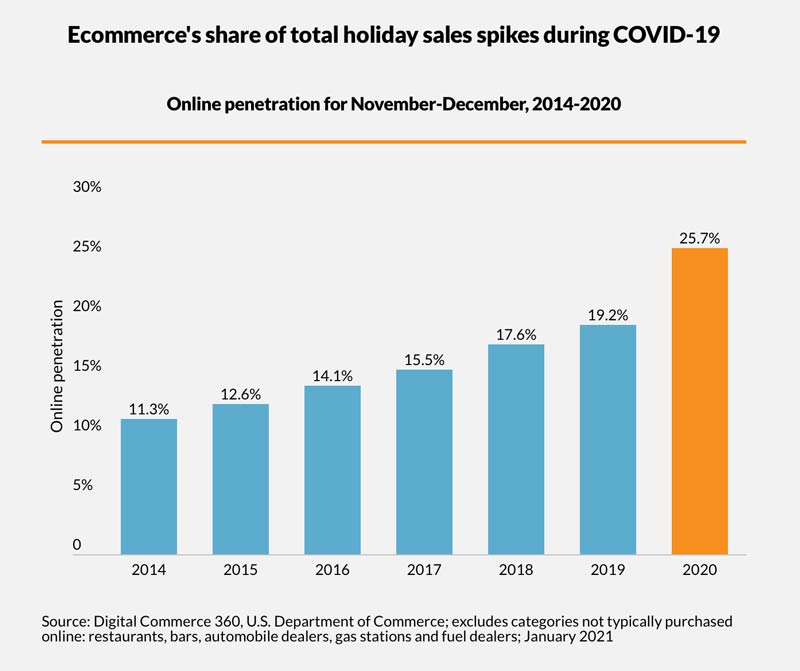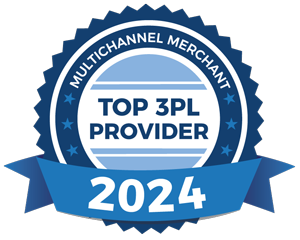Process 1000+ Orders a Month? Crush These 5 Fulfillment Challenges

As if 2020 wasn’t challenging enough for the world of ecommerce fulfillment, it might not get a whole lot easier for brands and retailers in 2021 – at least not in the next few months.
Some of the most common pandemic-fueled pain points that started to quickly sweep across the industry nearly 12 months ago are still packing a punch – from labor shortages and supply chain disruptions due to COVID, to carrier/shipping delays and of course significant increases in online orders and returns. In fact, online holiday sales more than tripled in November-December 2020 compared to the 2019 holiday season (see chart).
For those that are processing at least 1,000 orders a month, ecommerce order fulfillment challenges can add up fast – and negatively impact the success of business, fast.
Below is a quick look at 5 of the most common fulfillment pain points experienced by brands retailers (especially during peak seasons and unusual years like 2020/2021) and how they can be effectively managed with the right amount of planning and third-party help from fulfillment companies with valuable expertise and comprehensive capabilities.
eCommerce Fulfillment Challenges
1. Inventory Management
Brands and retailers have zero time for inventory-related issues such as lost product, damaged product, or backlogs. These type of fulfillment challenges can lead to major revenue loss in the form of delayed shipping, higher product returns, additional customer service needs, unhappy customers, and a negative brand experience.
Working with an experienced ecommerce fulfillment company can help alleviate many of the headaches associated with inventory management – especially when you’re dealing with thousands of orders per month. Most third-party fulfillment providers use a robust warehouse management system (WMS) that can effortlessly operate several warehouse and distribution functions like product receiving and inventory control as well as order processing and transportation. Having technology-enabled transportation capabilities integrated with WMS can help move products in and out of inventory faster and meet on-demand fulfillment logistics needs.
Some warehouse management systems like the one used at PFC even includes a labor-management system with team and employee time tracking so you can easily scale your warehouse/inventory personnel up or down based on activity.
2. Shipping Issues
No matter where your ecommerce orders are destined, the biggest challenges affiliated with shipping – especially in 2020 and very likely again in 2021 – are cost and speed. And an added pain point for this year is that carrier capacity constraints could be affected by COVID vaccine distribution throughout the U.S. and globally.
Without an efficient ecommerce fulfilment process in place, achieving lower shipping costs and faster shipping is hard to do. And today’s consumers not only want their packages to arrive quickly, but they want them to arrive with free shipping (or at the least with a very low shipping cost).
So, what’s the best way to get a shipping framework in place that will make your customers happy? Work with a 3PL fulfillment partner who can leverage their strategic locations, high shipping volumes, and long-standing carrier relationships to help you pull off the timing and pricing your customers expect.
Fulfillment providers will typically have centrally located facilities, which can help shave delivery time off of orders regardless of where the orders are shipping to. They can also create optimized shipping strategies for each client because they have the flexibility to use multiple carriers. That flexibility can deliver significant cost-saving and time-saving advantages. For example, PFC has the ability to rate shop, zone skip, and consolidate shipments for cost savings and fast delivery. And our high-volume drop trailer program with UPS, FedEx, and USPS allows us to reach 80% of the U.S. population in just a few days.
3. Lack of Personalization/Branding Capabilities

As ecommerce grows, so does the consumer’s desire to have a seamless and personalized brand experience. With so many more brands selling their goods online, it’s more important than ever to stand out from the sea of competition. And having creative, branded packaging with personalized touches is one way to build a deeper brand connection with customers.
Back in the early days of order fulfillment, consumers were satisfied to receive their online order in a plain and simple package – whether a brown box or a plain padded envelope. Today, consumer expectations are quite different. For some, it’s just as important how the package looks and feels as what’s on the inside! Customized fulfillment can leave a lasting impression, but few retailers and brands have the in-house capabilities to pull off a highly personalized brand experience.
Many third-party fulfillment experts offer a wide range of customization capabilities – from kitting and assembly services like gift wrapping and hand-written notes to other custom packaging solutions. Subscription boxes are also hugely popular these days. Everything from meat and men’s razors to pet toys and popcorn are available through subscription box services, and many fulfillment providers have the processes, equipment, and technical capabilities to manage a successful subscription program.
4. Inefficient Returns
In light of recent online shopping habits, product returns – and therefore product returns processing – have skyrocketed.
A 2020 consumer sentiment survey reported that 75% of consumers never feel guilt over making a return. And 75% of consumers said a poor returns experience was enough reason to not buy from that retailer again. As consumers become more confident in making product returns, brands and retailers need to not only have a consumer-friendly returns policy but they also need to be highly efficient in managing those returns. If they aren’t, dollars and customers will be lost.
A successful returns processing program can be set up and managed via a Return Merchandise Authorization System (RMA) – a dynamic technology interface often used by third-party fulfillment providers in managing their customers returns programs.
An RMA system will seamlessly handle pretty much every aspect of returns processing – communications regarding a returns status, returns verifications, credit reconciliation, product disposition, re-packaging/re-stocking, and online reporting for return order data.
If you’re regularly challenged by your returns processing, connecting with a fulfillment expert with RMA capabilities or other dynamic solutions can deliver big benefits.
5. Inadequate Reporting Tools

Reporting is always a critical piece of the ecommerce fulfillment puzzle, but it’s even more important during times of heightened online sales and increased fulfillment activity. Many brands and retailers can quickly fall short in leveraging reporting and important data when other aspects of their business get busy. But the reality is that having a powerful reporting tool that’s used in the right way is just as important as having a powerful product to sell – and a powerful ecommerce platform to sell it on.
A third-party fulfillment partner can provide comprehensive reporting technologies that give you 24/7/365 visibility into the hour-by-hour activities of your program. Access to your crucial data can happen anytime or anywhere via a web-based portal and can be easily shared via custom reports. The flexibility, power, and ease of use of these reporting platforms make them an integral part of the ecommerce fulfillment process that can’t be overlooked.
Contact PFC Fulfillment
If you need help crushing your biggest ecommerce fulfillment challenges, connect with the experts at PFC Fulfillment.

